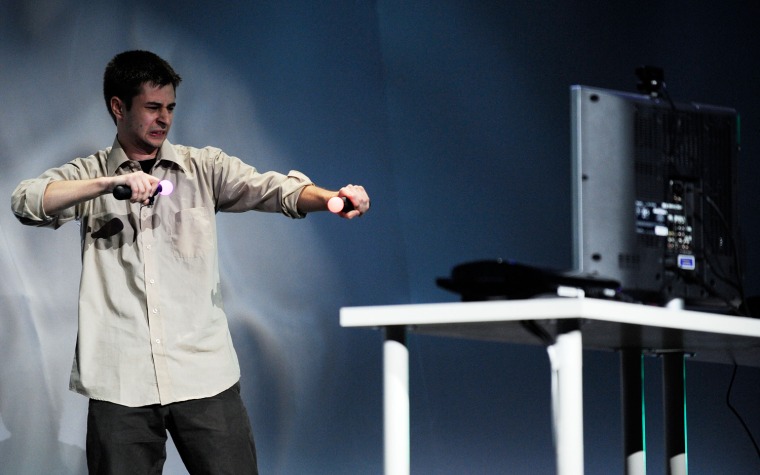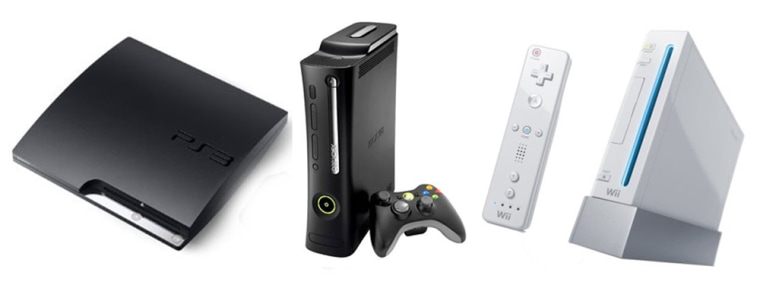Nintendo, Microsoft and Sony have spent a lot of time explaining to gamers and would-be gamers why each of their particular video game consoles are different (and, of course, better) than the competition’s. And yet, it seems that the more time passes, the more these companies are transforming their game machines into the same thing.
Last week, Nintendo announced that the Wii will begin streaming Netflix movies to its users this spring — hopping aboard a train that the Xbox 360 and the PS3 leapt on many months ago. Meanwhile, a high-definition-capable Wii is rumored to be in the works, at long last making the family-friendly console capable of offering pretty pictures on par with its competition.
And speaking of the competition, Microsoft and Sony will follow the Wii’s rather spectacular lead and offer newfangled motion controls for their consoles starting this fall — that’s Project Natal for the Xbox 360 and the (tentatively named) Motion Controller for the PS3.
Furthering the machine blur, gamers and analysts have been pushing for the Wii to offer more mature titles in its library (you know, just like the PS3 and the Xbox 360). Meanwhile, Microsoft and Sony are making moves to capture casual players and a broader audience (you know, just like the Wii).
But as each of these game consoles adopts the services, technologies and characteristics of the others, one can’t help but wonder: Will we all be playing the same console in the not-so-distant future — a PSWiiBox perhaps?
Four wheels and a combustion engine
Jesse Divnich, a games analyst with Electronic Entertainment Design and Research, says that to some degree this is just the way technology rolls.
“Throughout history, companies seem to converge around the same technologies,” he says. “If you look at automobiles today, all automobiles are very similar. They all have four wheels and they all have a combustion engine. But when they were first invented, that wasn’t the case.”
That’s right, if not for this tendency toward tech convergence, some of us could have been driving around Nicolas-Joseph Cugnot’s steam wagon today.
“Industries tend to eventually catch on to what consumers want, and companies eventually do just find the best strategies,” Divnich says. “And that’s what this comes down to — Microsoft, Sony and Nintendo want to have the core technologies that everybody wants.”
In fact, games analyst Michael Pachter of Wedbush Morgan Securities believes that longtime frontrunner Nintendo could lose major ground to its competition if the Wii doesn’t become more like, well, its competition.
“I’d say that the Wii’s appeal is kind of getting close to running its course,” he says.
He makes a good point. Consumers lining up the three consoles side by side in the store can’t help but want to get the most entertainment for their buck. With the PS3 offering a Blu-ray movie player, the Xbox 360 now offering access to 1080p instant-on streaming movies and both machines delivering robust online gaming and soon to deliver motion controls … the Wii (which doesn’t even have a DVD player) can seem to pale in comparison.
Pachter believes that Nintendo would be wise to launch a Wii HD with a built-in DVD player and more online features by the end of the year.
“They should announce it at E3 and roll the thing out in October and they ought to get together with Take-Two and have ‘Grand Theft Auto 5’ be a launch title,” he says, but adds: “They just don’t seem to agree with me.”
Everything to everyone?
Yes, Nintendo flat-out denies the existence of the Wii HD. And analyst Divnich flat-out disagrees with Pachter. He believes that consumers, and more importantly, investors, are asking too much of the company Mario built.

“Nintendo has done the impossible,” he says. “When the Wii was first revealed at E3 a few years back, a lot of people laughed. They thought it was a joke. And here we are three years later and it is literally controlling and dominating most of the gaming market. So I don’t necessarily believe Nintendo needs to build a Wii HD. What they’ve done so far has been successful.”
What’s more, Divnich says, the Big Three should beware of the temptation to be all things to all consumers.
Sony and Microsoft have been striving to create an all-in-one system — their latest-gen consoles aiming to be multimedia entertainment devices, complete with movie offerings, music, loads of online features and, oh yeah, all kinds of games too.
“But the truth is, creating an all-in-one system is very difficult because every time you try to add a new feature for one demographic, you alienate another demographic,” says Divnich. “It’s a very tough balancing act and I don’t know that it’s possible.”
For example, he points out that if Microsoft’s Project Natal ends up making the Xbox 360 seem too family-friendly (i.e. too Wii-like), it runs the risk of alienating the “Halo”-luvin’ core players that have helped make it a success.
To zig or to zag ... that is the question
So should each of these companies try to make their machines exactly like the others? The answer is no. Microsoft, Sony and Nintendo must continue to find new ways to set themselves apart even as they adopt similar technologies and services.
But how do they do that?
Certainly their exclusive first-party games will continue to be an important part of the equation. “Halo.” “LittleBigPlanet.” Anything Mario or Zelda. What games will we be able to play nowhere else?
Divnich says that when it comes to Microsoft and Sony — each offering machines that are far more similar to one another than they are the Wii — it’ll be a battle to see who delivers the best, most engaging new motion control system and software to go with it. At the same time, he says both companies must strive to differentiate their consoles by offering unique online services and features.
As far as Nintendo goes, Divnich believes that, rather than trying to bring more mature content to the Wii, it should continue to distinguish itself as the family-centric machine it is. Just because some of us have grown up and now want Nintendo to grow up with us, doesn’t mean that it should.
After all, “it’s not like people are going to stop having kids,” he says. “There are new potential consumers coming in all the time.”
Pachter says that, ultimately, there’s no predicting what Nintendo will do to set itself apart as Microsoft and Sony adopt the motion-control tech the Wii popularized.
“Nintendo has tended to zag when other people zig,” he says. “So the question is, as the other guys move closer to them, will they move somewhere else? I don’t want to rule out their ability to innovate and surprise us with what they do.”
Nintendo of America president Reggie Fils-Aime certainly doesn’t seem concerned about standing out on the playing field. Though he wouldn’t offer specifics, he said the company will continue to set itself apart with its unique software offerings.
“In the end, it all comes down to the content itself, the software and the experience,” he said. “That’s where I would put ‘Wii Sports Resort’ or ‘Wii Sports’ up against any motion-based family game. And I look forward to seeing how the competitor offerings stand up to those pieces of software.”
Ultimately, all this jockeying to adopt and adapt each other’s technologies and services hasn’t been a bad thing for the industry — or for gamers.
“I think this generation of consoles has been more competitive than any other,” Divnich says. “And that’s good because it creates more innovation and that’s why we get things like Netflix implemented into our Xbox accounts, that’s how we get motion controls and that’s how we get new games.”
Winda Benedetti predicts she will launch Winda HD in the year 2012. She'll be tweeting all about it .
